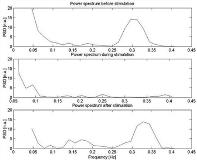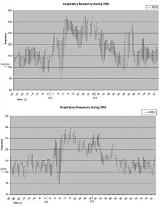CARDIORESPIRATORY EFFECTS OF THE VAGUS NERVE STIMULATION IN EPILEPTIC CHILDREN
Abstract number :
1.419
Submission category :
Year :
2004
Submission ID :
4447
Source :
www.aesnet.org
Presentation date :
12/2/2004 12:00:00 AM
Published date :
Dec 1, 2004, 06:00 AM
Authors :
1Boubker Zaaimi, 1Mickael Pruvost, 3Patrick Berquin, 1Reinhard Grebe, and 1,2Fabrice Wallois
Vagus nerve stimulation (VNS) is used as an approved treatment to reduce seizures in patients with drug resistant epilepsy. It[rsquo]s an empirically based method for the treatment of epilepsy by repeated stimulations of the left vagus nerve through implanted electrodes. Only few data are available in humans about the effects of VNS on respiration. VNS has also an impact on heart rate variability (HRV). We analyzed physiological cardiorespiratory responses to VNS in 10 epileptic children during polygraphic sleep recording. In normal case, HRV presents two major components of frequency: low frequency (LF), and high frequency (HF). Modifications in the LF/HF ratio are indicative of variations in sympathovagal balance. The distribution of the power and the central frequency of LF and HF vary in relation to changes in autonomic modulations of the heart period. We demonstrate that VNS, in children, induces repetitively a first significant increase in respiratory frequency (10% to 25%; p[lt]0.05). This first increase is followed by a decrease in respiratory frequency which reach baseline values by the end of the stimulation. In parallel, the amplitude decreases by 25% to 40% (p[lt]0.05) from baseline. For some patients these effects are more pronounced during NREM than during REM sleep. Linked to VNS, they vary during the night. This variability is also more pronounced during REM (p= 0.0012). These respiratory responses are proportionally related to the intensity of stimulation. In some children, these effects result in a decrease in SaO[sub]2[/sub] (from 98% to 94%).
The tachogram analysis of the ECG of children treated by VNS, demonstrates a significant difference between the 2 components during stimulation than normal case. (2.27[plusmn]0.62 n.u. vs 0.55[plusmn]0.21 n.u.). VNS induces repetitive reversible (1) respiratory restrictive syndrome (decrease of the amplitude, and increase of respiratory frequency), (2) change in sympathovagal balance and (3) decrease in SaO[sub]2[/sub]. Those VNS consequences on the vegetative system might serve to optimize the stimulation parameters when correlated to the drop in epileptic seizures.[figure1][figure2] (Supported by Alternatech, Conseil Regional de Picardie and Cyberonics.)

